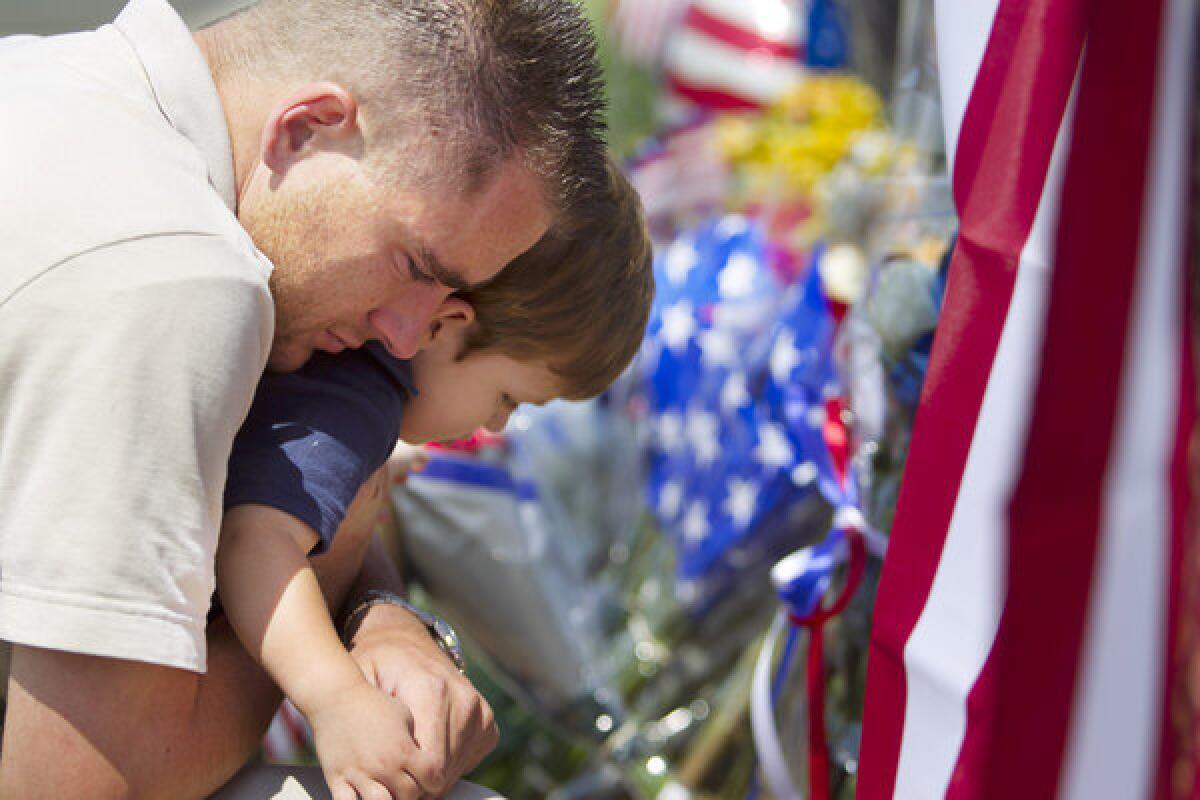Arizona wildfire raises question: What have past fires taught us?

- Share via
The fire was spreading fast, and the foreman knew it was too late to run. So Wagner Dodge struck a match and tried to save his fellow smoke jumpers by lighting a fire himself and then seeking shelter in the area that had just burned. But 13 firefighters weren’t sure that the tactic would work, and they tried to run, dying along the way.
It may sound like a scene from this year, or this decade, but it happened during the 1949 Mann Gulch fire in Montana. One of the best-known fires in American history, it has been memorialized in songs such as “Cold Missouri Waters” and in books such as Norman Maclean’s mournful “Young Men and Fire.” It’s one of dozens of fires that have captured the nation’s attention as people have cut through the wilderness and built cities and towns.
Some things have changed since the 1949 fire — smoke jumpers, part of the Mann Gulch crew, were relatively new then, and technology primitive compared with now. But fire historians say the blazes that continue to churn through the West each year have much in common with wildfires in the past.
PHOTOS: Yarnell Hill fire in Arizona
“In some ways we’re willing to tolerate it in the same way that even the 19th century did,” Stephen Pyne, a fire historian at Arizona State University, said of fire near civilization.
It wasn’t always just the West that was ravaged with fire. In the 19th century, the New England skies would be filled with smoke as fires raged around newly built-up areas, Pyne said. As cities popped up in the East and then the Midwest and humans cleared land, built homes and buildings and laid railroad tracks, they also created a wave of horrific fires — or noticed ones that might have gone unnoticed before.
One of the biggest blazes, the Peshtigo fire of 1871 in Wisconsin, killed hundreds if not thousands. A fire in Hinkley, Minn., in 1894 killed more than 400. The large number of deaths occurred because communication was slow and towns didn’t learn about the fire until it arrived, and because authorities would evacuate people on trains but then the tracks would melt from the heat, Pyne said.
“We have this wave of horrible fires accompanying agricultural settlement,” he said. Each time people moved out into the country, whether to start new farms of develop suburbs, fires followed. “In effect, we’ve set up a new wave of colonizing fires,” he said.
The Great Fire of 1910, which gave rise to the modern Forest Service, burned 3 million acres in Idaho in 48 hours. In an era of sensationalism in journalism, the fire was covered by news media from all over the world, which portrayed the people fighting the blaze — often convicts or men from off the street — as heroes.
“Anyone who had a pulse, they were throwing up against the fire,” said Timothy Egan, who wrote about the blaze in “The Big Burn: Teddy Roosevelt and the Fire that Saved America.”
Egan argues that the fire saved American wilderness because it helped voters and Congress realize that the newly founded National Forest Service, which had been on the chopping block because of budget cuts, was a necessary agency for a growing country. The 1910 fire also made some in the government understand that the acres of wilderness that were quickly being chopped down were valuable and needed to be saved, an idea that led to the creation of wilderness lands, Egan said in an interview.
But the response to that fire had more dangerous repercussions too: The public expected the Forest Service to put out blazes with minimal deaths, Egan said, and the Forest Service tried to comply.
“People expect them to put out wildfires — and the Forest Service becomes the fire service. They still try to put out every fire,” he said. “They always vow [firefighter deaths] are never going to happen again, but they just keep repeating themselves.”
Added Chad Hoffman at Colorado State University’s Western Forest Fire Research Center, “The 1910 fire really stands out, in part because the idea that we’re going to suppress fires really comes to the forefront of fire policy.”
The drought in the 1930s kept firefighters busy, with giant fires in Tillamook, Ore., and Griffith Park in Los Angeles. Historians remember the Griffith Park fire because of the number of lives lost. What started as a small brush fire killed at least 25 firefighters, even though more than 3,000 workers were employed at Griffith Park at the time.
By the time the Mann Gulch fire killed 13 in 1949, the idea that fires could be fought and put out had gained prominence. Smoke jumpers, who parachuted into remote areas, were a new addition to the Forest Service’s tools, and the way Dodge set a fire to save himself soon became a new way to control burns.
But the dramatic story of so many crew members losing their lives made some people question whether it was worth trying to save man-made structures from fire, said Patty Limerick, chairwoman of the board of the Center of the American West at the University of Colorado.
“The Mann Gulch fire in the 1940s was lesson in the vulnerability of firefighters, and in betting people’s lives in the goal of fire suppression,” she said. “There were some important lessons that people have really struggled to apply.”
As civilization spread out again to the wilderness, those lessons were hard to remember, especially when homes and towns were at risk. Storm King Mountain near Glenwood, Colo., saw a 1994 effort to control a fast-moving fire by deploying hot shots and smoke jumpers, but because of bureaucracy and bad management, it killed 14. That fire also spawned a book by John Maclean — the son of Norman Mclean — called “Fire on the Mountain: The True Story of the South Canyon Fire” (the fire is known as both the South Canyon fire and the Storm King fire).
“Storm King was really an awakening for the firefighting community — there was a lot of reflection, lesson taking,” Limerick said. “That had a very big impact on how firefighting professionals handled themselves, made their decisions. The idea became you can say no — if you’re given an order, you can say no.”
Blazes since Storm King have often forced firefighters to ask themselves a question — whether they’re willing to say no to an order to deploy to put out a fire that may save homes but may also take their lives.
INTERACTIVE GRAPHIC: Suiting up to fight fires
It’s an issue the nation will have to grapple with if people are going to keep moving into nature, much the way early settlers did. After all, fires can blaze for months if nothing is in the way — a 1950 fire in Canada began in the spring and burned through to the fall, Pyne said.
The technology has changed since Americans started to pay attention to the fires ravaging the landscape in the 19th century: There are agencies to fight them, elite squads to send on the ground, communications that can evacuate whole towns. But in many ways, we haven’t learned much at all, Pyne said. Humans should have learned by now that they can’t suppress fire and that fire will tear through areas that people try to tame.
“We’re going through an equivalent era — sprawl has moved into areas and made them more fire prone,” Pyne said. “You have the continual development pushing on the borders of the public lands, you’ve got this frontier that is full of fire. We need again to think about how we should intervene.”
ALSO:
Las Vegas audience saw Cirque du Soleil performer’s fatal plunge
Battle of Gettysburg’s 150th anniversary has the town in high gear
Jury hears Zimmerman’s voice describe shooting of Trayvon Martin
More to Read
Sign up for Essential California
The most important California stories and recommendations in your inbox every morning.
You may occasionally receive promotional content from the Los Angeles Times.











